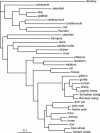The complete sequence of the zebrafish (Danio rerio) mitochondrial genome and evolutionary patterns in vertebrate mitochondrial DNA
- PMID: 11691861
- PMCID: PMC311132
- DOI: 10.1101/gr.156801
The complete sequence of the zebrafish (Danio rerio) mitochondrial genome and evolutionary patterns in vertebrate mitochondrial DNA
Abstract
We describe the complete sequence of the 16,596-nucleotide mitochondrial genome of the zebrafish (Danio rerio); contained are 13 protein genes, 22 tRNAs, 2 rRNAs, and a noncoding control region. Codon usage in protein genes is generally biased toward the available tRNA species but also reflects strand-specific nucleotide frequencies. For 19 of the 20 amino acids, the most frequently used codon ends in either A or C, with A preferred over C for fourfold degenerate codons (the lone exception was AUG: methionine). We show that rates of sequence evolution vary nearly as much within vertebrate classes as between them, yet nucleotide and amino acid composition show directional evolutionary trends, including marked differences between mammals and all other taxa. Birds showed similar compositional characteristics to the other nonmammalian taxa, indicating that the evolutionary trend in mammals is not solely due to metabolic rate and thermoregulatory factors. Complete mitochondrial genomes provide a large character base for phylogenetic analysis and may provide for robust estimates of phylogeny. Phylogenetic analysis of zebrafish and 35 other taxa based on all protein-coding genes produced trees largely, but not completely, consistent with conventional views of vertebrate evolution. It appears that even with such a large number of nucleotide characters (11,592), limited taxon sampling can lead to problems associated with extensive evolution on long phyletic branches.
Figures


References
-
- Boore JL, Brown WM. Big trees from little genomes: Mitochondrial gene order as a phylogenetic tool. Curr Opin Genet Dev. 1998;8:668–674. - PubMed
-
- Brown W M. The mitochondrial genome of animals. In: MacIntyre RJ, editor. Molecular evolutionary genetics. New York: Plenum; 1985. pp. 95–130.
Publication types
MeSH terms
Substances
LinkOut - more resources
Full Text Sources
Other Literature Sources
Molecular Biology Databases
